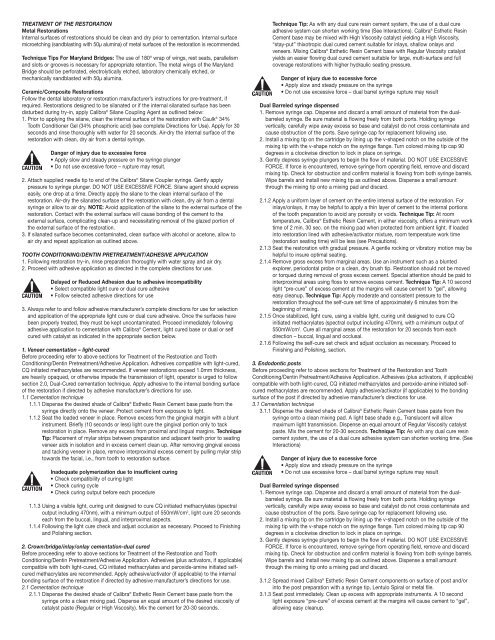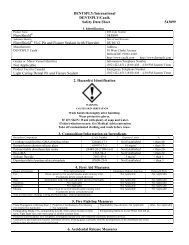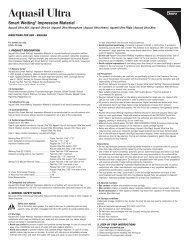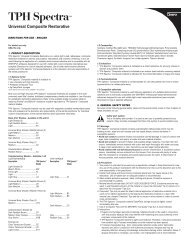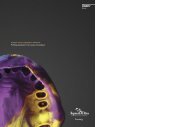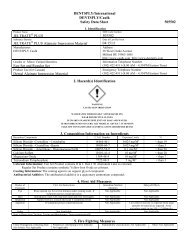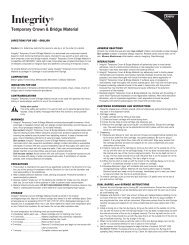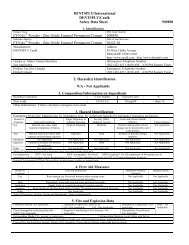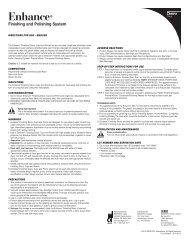Calibra - Caulk
Calibra - Caulk
Calibra - Caulk
Create successful ePaper yourself
Turn your PDF publications into a flip-book with our unique Google optimized e-Paper software.
TREATMENT OF THE RESTORATION<br />
Metal Restorations<br />
Internal surfaces of restorations should be clean and dry prior to cementation. Internal surface<br />
microetching (sandblasting with 50µ alumina) of metal surfaces of the restoration is recommended.<br />
Technique Tips For Maryland Bridges: The use of 180º wrap of wings, rest seats, parallelism<br />
and slots or grooves is necessary for appropriate retention. The metal wings of the Maryland<br />
Bridge should be perforated, electrolytically etched, laboratory chemically etched, or<br />
mechanically sandblasted with 50µ alumina.<br />
Ceramic/Composite Restorations<br />
Follow the dental laboratory or restoration manufacturer’s instructions for pre-treatment, if<br />
required. Restorations designed to be silanated or if the internal silanated surface has been<br />
disturbed during try-in, apply <strong>Calibra</strong> ® Silane Coupling Agent as outlined below:<br />
1. Prior to applying the silane, clean the internal surface of the restoration with <strong>Caulk</strong> ® 34%<br />
Tooth Conditioner Gel (34% phosphoric acid) (see complete Directions for Use). Apply for 30<br />
seconds and rinse thoroughly with water for 20 seconds. Air-dry the internal surface of the<br />
restoration with clean, dry air from a dental syringe.<br />
Danger of injury due to excessive force<br />
• Apply slow and steady pressure on the syringe plunger<br />
• Do not use excessive force – rupture may result.<br />
2. Attach supplied needle tip to end of the <strong>Calibra</strong> ® Silane Coupler syringe. Gently apply<br />
pressure to syringe plunger. DO NOT USE EXCESSIVE FORCE. Silane agent should express<br />
easily, one drop at a time. Directly apply the silane to the clean internal surface of the<br />
restoration. Air-dry the silanated surface of the restoration with clean, dry air from a dental<br />
syringe or allow to air dry. NOTE: Avoid application of the silane to the external surface of the<br />
restoration. Contact with the external surface will cause bonding of the cement to the<br />
external surface, complicating clean-up and necessitating removal of the glazed portion of<br />
the external surface of the restoration.<br />
3. If silanated surface becomes contaminated, clean surface with alcohol or acetone, allow to<br />
air dry and repeat application as outlined above.<br />
TOOTH CONDITIONING/DENTIN PRETREATMENT/ADHESIVE APPLICATION<br />
1. Following restoration try-in, rinse preparation thoroughly with water spray and air dry.<br />
2. Proceed with adhesive application as directed in the complete directions for use.<br />
Delayed or Reduced Adhesion due to adhesive incompatibility<br />
• Select compatible light cure or dual cure adhesive<br />
• Follow selected adhesive directions for use<br />
3. Always refer to and follow adhesive manufacturer’s complete directions for use for selection<br />
and application of the appropriate light cure or dual cure adhesive. Once the surfaces have<br />
been properly treated, they must be kept uncontaminated. Proceed immediately following<br />
adhesive application to cementation with <strong>Calibra</strong> ® Cement, light cured base or dual or self<br />
cured with catalyst as indicated in the appropriate section below.<br />
1. Veneer cementation – light-cured<br />
Before proceeding refer to above sections for Treatment of the Restoration and Tooth<br />
Conditioning/Dentin Pretreatment/Adhesive Application. Adhesives compatible with light-cured,<br />
CQ initiated methacrylates are recommended. If veneer restorations exceed 1.0mm thickness,<br />
are heavily opaqued, or otherwise impede the transmission of light, operator is urged to follow<br />
section 2.0, Dual-Cured cementation technique. Apply adhesive to the internal bonding surface<br />
of the restoration if directed by adhesive manufacturer’s directions for use.<br />
1.1 Cementation technique<br />
1.1.1 Dispense the desired shade of <strong>Calibra</strong> ® Esthetic Resin Cement base paste from the<br />
syringe directly onto the veneer. Protect cement from exposure to light.<br />
1.1.2 Seat the loaded veneer in place. Remove excess from the gingival margin with a blunt<br />
instrument. Briefly (10 seconds or less) light cure the gingival portion only to tack<br />
restoration in place. Remove any excess from proximal and lingual margins. Technique<br />
Tip: Placement of mylar strips between preparation and adjacent teeth prior to seating<br />
veneer aids in isolation and in excess cement clean up. After removing gingival excess<br />
and tacking veneer in place, remove interproximal excess cement by pulling mylar strip<br />
towards the facial, i.e., from tooth to restoration surface.<br />
Inadequate polymerization due to insufficient curing<br />
• Check compatibility of curing light<br />
• Check curing cycle<br />
• Check curing output before each procedure<br />
1.1.3 Using a visible light, curing unit designed to cure CQ initiated methacrylates (spectral<br />
output including 470nm), with a minimum output of 550mW/cm 2 , light cure 20 seconds<br />
each from the buccal, lingual, and interproximal aspects.<br />
1.1.4 Following the light cure check and adjust occlusion as necessary. Proceed to Finishing<br />
and Polishing section.<br />
2. Crown/bridge/inlay/onlay cementation-dual cured<br />
Before proceeding refer to above sections for Treatment of the Restoration and Tooth<br />
Conditioning/Dentin Pretreatment/Adhesive Application. Adhesives (plus activators, if applicable)<br />
compatible with both light-cured, CQ initiated methacrylates and peroxide-amine initiated selfcured<br />
methacrylates are recommended. Apply adhesive/activator (if applicable) to the internal<br />
bonding surface of the restoration if directed by adhesive manufacturer’s directions for use.<br />
2.1 Cementation technique<br />
2.1.1 Dispense the desired shade of <strong>Calibra</strong> ® Esthetic Resin Cement base paste from the<br />
syringe onto a clean mixing pad. Dispense an equal amount of the desired viscosity of<br />
catalyst paste (Regular or High Viscosity). Mix the cement for 20-30 seconds.<br />
Technique Tip: As with any dual cure resin cement system, the use of a dual cure<br />
adhesive system can shorten working time (See Interactions). <strong>Calibra</strong> ® Esthetic Resin<br />
Cement base may be mixed with High Viscosity catalyst yielding a High Viscosity,<br />
“stay-put” thixotropic dual cured cement suitable for inlays, shallow onlays and<br />
veneers. Mixing <strong>Calibra</strong> ® Esthetic Resin Cement base with Regular Viscosity catalyst<br />
yields an easier flowing dual cured cement suitable for large, multi-surface and full<br />
coverage restorations with higher hydraulic seating pressure.<br />
Danger of injury due to excessive force<br />
• Apply slow and steady pressure on the syringe<br />
• Do not use excessive force – dual barrel syringe rupture may result<br />
Dual Barreled syringe dispensed<br />
1. Remove syringe cap. Dispense and discard a small amount of material from the dualbarreled<br />
syringe. Be sure material is flowing freely from both ports. Holding syringe<br />
vertically, carefully wipe away excess so base and catalyst do not cross contaminate and<br />
cause obstruction of the ports. Save syringe cap for replacement following use.<br />
2. Install a mixing tip on the cartridge by lining up the v-shaped notch on the outside of the<br />
mixing tip with the v-shape notch on the syringe flange. Turn colored mixing tip cap 90<br />
degrees in a clockwise direction to lock in place on syringe.<br />
3. Gently depress syringe plungers to begin the flow of material. DO NOT USE EXCESSIVE<br />
FORCE. If force is encountered, remove syringe from operating field, remove and discard<br />
mixing tip. Check for obstruction and confirm material is flowing from both syringe barrels.<br />
Wipe barrels and install new mixing tip as outlined above. Dispense a small amount<br />
through the mixing tip onto a mixing pad and discard.<br />
2.1.2 Apply a uniform layer of cement on the entire internal surface of the restoration. For<br />
inlays/onlays, it may be helpful to apply a thin layer of cement to the internal portions<br />
of the tooth preparation to avoid any porosity or voids. Technique Tip: At room<br />
temperature, <strong>Calibra</strong> ® Esthetic Resin Cement, in either viscosity, offers a minimum work<br />
time of 2 min. 30 sec. on the mixing pad when protected from ambient light. If loaded<br />
into restoration lined with adhesive/activator mixture, room temperature work time<br />
(restoration seating time) will be less (see Precautions).<br />
2.1.3 Seat the restoration with gradual pressure. A gentle rocking or vibratory motion may be<br />
helpful to insure optimal seating.<br />
2.1.4 Remove gross excess from marginal areas. Use an instrument such as a blunted<br />
explorer, periodontal probe or a clean, dry brush tip. Restoration should not be moved<br />
or torqued during removal of gross excess cement. Special attention should be paid to<br />
interproximal areas using floss to remove excess cement. Technique Tip: A 10 second<br />
light “pre-cure” of excess cement at the margins will cause cement to “gel”, allowing<br />
easy cleanup. Technique Tip: Apply moderate and consistent pressure to the<br />
restoration throughout the self-cure set time of approximately 6 minutes from the<br />
beginning of mixing.<br />
2.1.5 Once stabilized, light cure, using a visible light, curing unit designed to cure CQ<br />
initiated methacrylates (spectral output including 470nm), with a minimum output of<br />
550mW/cm 2 . Cure all marginal areas of the restoration for 20 seconds from each<br />
direction – buccal, lingual and occlusal.<br />
2.1.6 Following the self-cure set check and adjust occlusion as necessary. Proceed to<br />
Finishing and Polishing, section.<br />
3. Endodontic posts<br />
Before proceeding refer to above sections for Treatment of the Restoration and Tooth<br />
Conditioning/Dentin Pretreatment/Adhesive Application. Adhesives (plus activators, if applicable)<br />
compatible with both light-cured, CQ initiated methacrylates and peroxide-amine initiated selfcured<br />
methacrylates are recommended. Apply adhesive/activator (if applicable) to the bonding<br />
surface of the post if directed by adhesive manufacturer’s directions for use.<br />
3.1 Cementation technique<br />
3.1.1 Dispense the desired shade of <strong>Calibra</strong> ® Esthetic Resin Cement base paste from the<br />
syringe onto a clean mixing pad. A light base shade e.g., Translucent will allow<br />
maximum light transmission. Dispense an equal amount of Regular Viscosity catalyst<br />
paste. Mix the cement for 20-30 seconds. Technique Tip: As with any dual cure resin<br />
cement system, the use of a dual cure adhesive system can shorten working time. (See<br />
Interactions)<br />
Danger of injury due to excessive force<br />
• Apply slow and steady pressure on the syringe<br />
• Do not use excessive force – dual barrel syringe rupture may result<br />
Dual Barreled syringe dispensed<br />
1. Remove syringe cap. Dispense and discard a small amount of material from the dualbarreled<br />
syringe. Be sure material is flowing freely from both ports. Holding syringe<br />
vertically, carefully wipe away excess so base and catalyst do not cross contaminate and<br />
cause obstruction of the ports. Save syringe cap for replacement following use.<br />
2. Install a mixing tip on the cartridge by lining up the v-shaped notch on the outside of the<br />
mixing tip with the v-shape notch on the syringe flange. Turn colored mixing tip cap 90<br />
degrees in a clockwise direction to lock in place on syringe.<br />
3. Gently depress syringe plungers to begin the flow of material. DO NOT USE EXCESSIVE<br />
FORCE. If force is encountered, remove syringe from operating field, remove and discard<br />
mixing tip. Check for obstruction and confirm material is flowing from both syringe barrels.<br />
Wipe barrels and install new mixing tip as outlined above. Dispense a small amount<br />
through the mixing tip onto a mixing pad and discard.<br />
3.1.2 Spread mixed <strong>Calibra</strong> ® Esthetic Resin Cement components on surface of post and/or<br />
into the post preparation with a syringe tip, Lentulo Spiral or metal file.<br />
3.1.3 Seat post immediately. Clean up excess with appropriate instruments. A 10 second<br />
light exposure “pre-cure” of excess cement at the margins will cause cement to “gel”,<br />
allowing easy cleanup.


